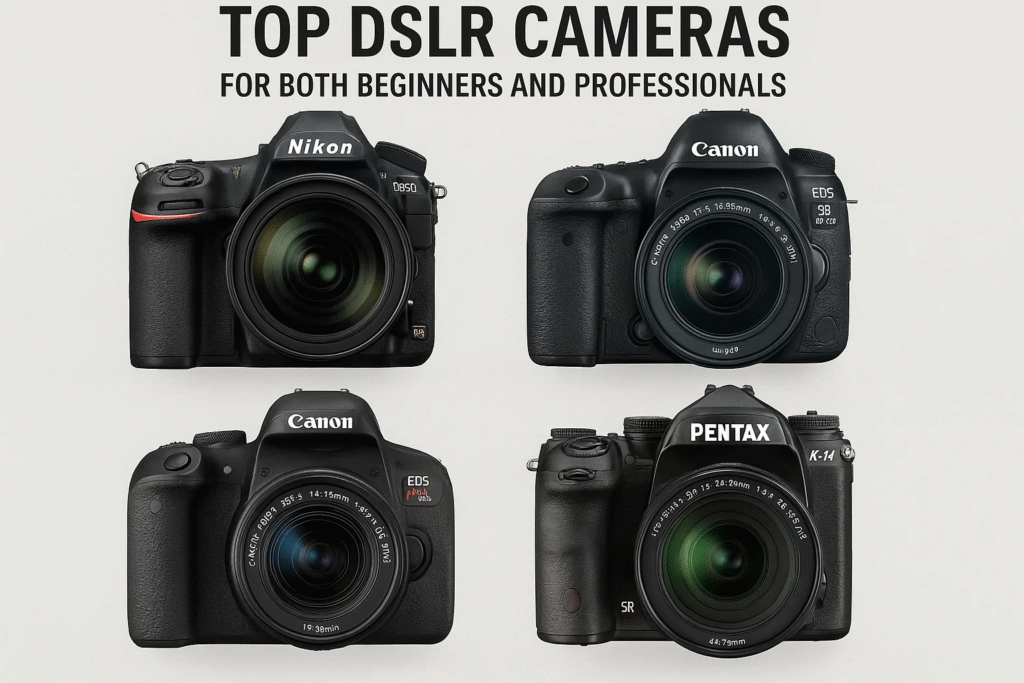In the world of photography, DSLR (Digital Single-Lens Reflex) cameras continue to dominate despite the rise of mirrorless systems. They provide unmatched versatility, image quality, and the ability to change lenses according to the shooting requirement. Whether you are a beginner stepping into the world of photography or a professional capturing high-quality images, choosing the right DSLR is crucial. This guide will walk you through some of the top DSLR cameras suitable for both beginners and professionals, along with their features, advantages, and what makes them stand out.
Why Choose a DSLR Camera?
Before diving into the list of cameras, it’s important to understand why DSLR cameras are still preferred by many photographers:
-
Image Quality – DSLRs have large sensors that capture high-resolution images with excellent detail and dynamic range.
-
Interchangeable Lenses – You can use a wide variety of lenses to suit portraits, landscapes, macro, sports, or wildlife photography.
-
Optical Viewfinder – Unlike some digital cameras, the optical viewfinder gives a real-time, clear view of the scene.
-
Durability – DSLRs are robust, weather-sealed, and can withstand heavy use.
-
Manual Controls – Ideal for those who want full creative control over settings like ISO, shutter speed, and aperture.

DSLR Cameras for Beginners
If you are a beginner, the goal is to find a camera that is easy to use, versatile, and affordable, yet provides good image quality. Here are some top options:
| Camera Model | Sensor | Megapixels | Video | ISO Range | Weight | Why it’s Good for Beginners |
|---|---|---|---|---|---|---|
| Canon EOS Rebel T8i | APS-C | 24.1 MP | 4K | 100-25600 | 532 g | Intuitive interface, Dual Pixel AF, beginner-friendly guided modes |
| Nikon D3500 | APS-C | 24.2 MP | Full HD | 100-25600 | 415 g | Lightweight, excellent battery life, easy-to-learn controls |
| Canon EOS 2000D | APS-C | 24.1 MP | Full HD | 100-6400 | 475 g | Affordable, simple menus, good image quality for beginners |
| Nikon D5600 | APS-C | 24.2 MP | Full HD | 100-25600 | 465 g | Vari-angle touchscreen, good connectivity options, great lens selection |
| Pentax K-70 | APS-C | 24.2 MP | Full HD | 100-102400 | 688 g | Weather-sealed, in-body stabilization, ideal for outdoor photography |
Key Notes for Beginners:
-
Lightweight cameras like Nikon D3500 make long photography sessions less tiring.
-
Guided interfaces help you understand the settings without overwhelming technical terms.
-
In-camera stabilization (like Pentax K-70) helps reduce blur in handheld shots.
DSLR Cameras for Professionals
Professional photographers often need high resolution, fast autofocus, durability, and advanced video capabilities. Here are some top DSLRs for professionals:
| Camera Model | Sensor | Megapixels | Video | ISO Range | Weight | Why Professionals Choose It |
|---|---|---|---|---|---|---|
| Canon EOS 5D Mark IV | Full Frame | 30.4 MP | 4K | 100-32000 | 890 g | Excellent image quality, robust build, versatile for portrait and landscape |
| Nikon D850 | Full Frame | 45.7 MP | 4K | 64-25600 | 915 g | High resolution, superb dynamic range, ideal for studio and landscape |
| Canon EOS-1D X Mark III | Full Frame | 20.1 MP | 5.5K | 100-102400 | 1440 g | Fastest autofocus, high-speed shooting, sports and wildlife photography |
| Nikon D6 | Full Frame | 20.8 MP | 4K | 100-102400 | 1240 g | Professional-grade durability, exceptional autofocus, ideal for sports |
| Pentax K-1 Mark II | Full Frame | 36.4 MP | Full HD | 100-819200 | 1010 g | Weather-sealed, high resolution, great for outdoor and adventure photography |
Key Notes for Professionals:
-
Full-frame sensors offer better low-light performance and shallow depth of field.
-
High ISO capabilities allow shooting in extremely low light.
-
Robust build and weather sealing are essential for field photography.
Features to Consider Before Buying
When choosing a DSLR camera, whether you’re a beginner or professional, consider the following key features:
1. Sensor Size
-
APS-C Sensor: Compact, lighter, and affordable. Common in beginner DSLRs.
-
Full-frame Sensor: Offers better low-light performance, dynamic range, and professional quality.
2. Megapixels
-
Higher megapixels allow larger prints and detailed cropping.
-
Beginners usually don’t need extremely high megapixels (20-24 MP is enough).
-
Professionals benefit from 30-50+ MP for commercial and print work.
3. Autofocus System
-
Beginners benefit from cameras with easy-to-use AF modes.
-
Professionals need advanced AF with multiple points, tracking, and face detection for fast action.
4. Video Capabilities
-
Full HD (1080p) is sufficient for beginners.
-
Professionals may need 4K or higher resolution with frame rate options for cinematic footage.
5. Build and Durability
-
Beginners can use lightweight plastic bodies.
-
Professionals need magnesium alloy, weather-sealed cameras for rugged use.
6. Lens Compatibility
-
Beginners may stick with kit lenses like 18-55mm.
-
Professionals often invest in prime lenses (50mm, 85mm) or telephoto lenses for specific purposes.
Accessories for DSLR Cameras
Regardless of your skill level, some accessories can significantly improve your photography experience:
-
Tripods – Ensure stability for long exposures or low-light photography.
-
External Flash – Helps in portrait and indoor photography.
-
Camera Bag – Protects the camera and lenses during travel.
-
Extra Batteries & Memory Cards – Essential for long shoots.
-
Filters (UV, Polarizer, ND) – Enhance image quality and creative effects.
-
Remote Shutter Release – Useful for long exposures or wildlife photography.
Tips for Beginners
-
Start with manual mode practice – Learn ISO, shutter speed, and aperture to control your images.
-
Don’t focus only on megapixels – Composition and lighting are more important.
-
Experiment with different lenses to understand how focal length changes perspective.
-
Shoot in RAW format for better post-processing flexibility.
-
Regularly clean your sensor and lenses to avoid dust spots in photos.
Tips for Professionals
-
Invest in high-quality lenses – Often, lens quality matters more than the camera body.
-
Use dual card slots for backup and storage security.
-
Learn advanced metering and AF modes for action or landscape photography.
-
Consider weather-sealed gear for outdoor shoots.
-
Keep updating firmware and software for optimal camera performance.
Comparison Table of Beginner vs Professional DSLRs
| Feature | Beginner DSLR | Professional DSLR |
|---|---|---|
| Sensor | APS-C | Full-frame |
| Weight | Lightweight | Heavier, rugged |
| Megapixels | 20-24 MP | 20-50+ MP |
| Autofocus | Basic | Advanced, multi-point |
| Video | Full HD | 4K or higher |
| Price Range | $400-$900 | $2500-$7000+ |
| Ease of Use | Simple menus, guided modes | Advanced controls, customizable settings |
| Ideal For | Learning photography, casual shooting | Professional work, commercial projects |
Conclusion
Choosing the right DSLR depends on your experience level, budget, and photography goals. Beginners should focus on cameras that are easy to handle, lightweight, and have a simple learning curve, while professionals should prioritize image quality, autofocus speed, durability, and lens options. With the right DSLR and a few essential accessories, you can capture breathtaking images, whether it’s family photos, landscapes, portraits, or professional shoots.
Investing time in learning your camera, understanding composition, and experimenting with different settings will ultimately make the biggest difference. DSLRs, even in the age of smartphones and mirrorless cameras, remain powerful tools for those serious about photography.


